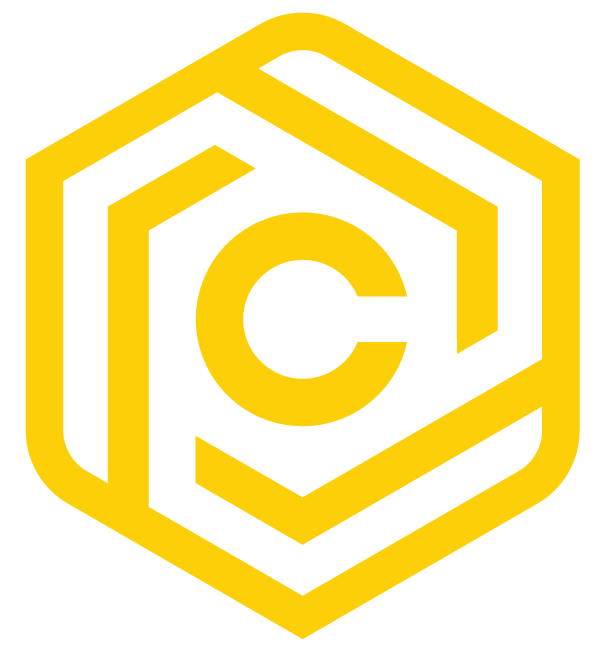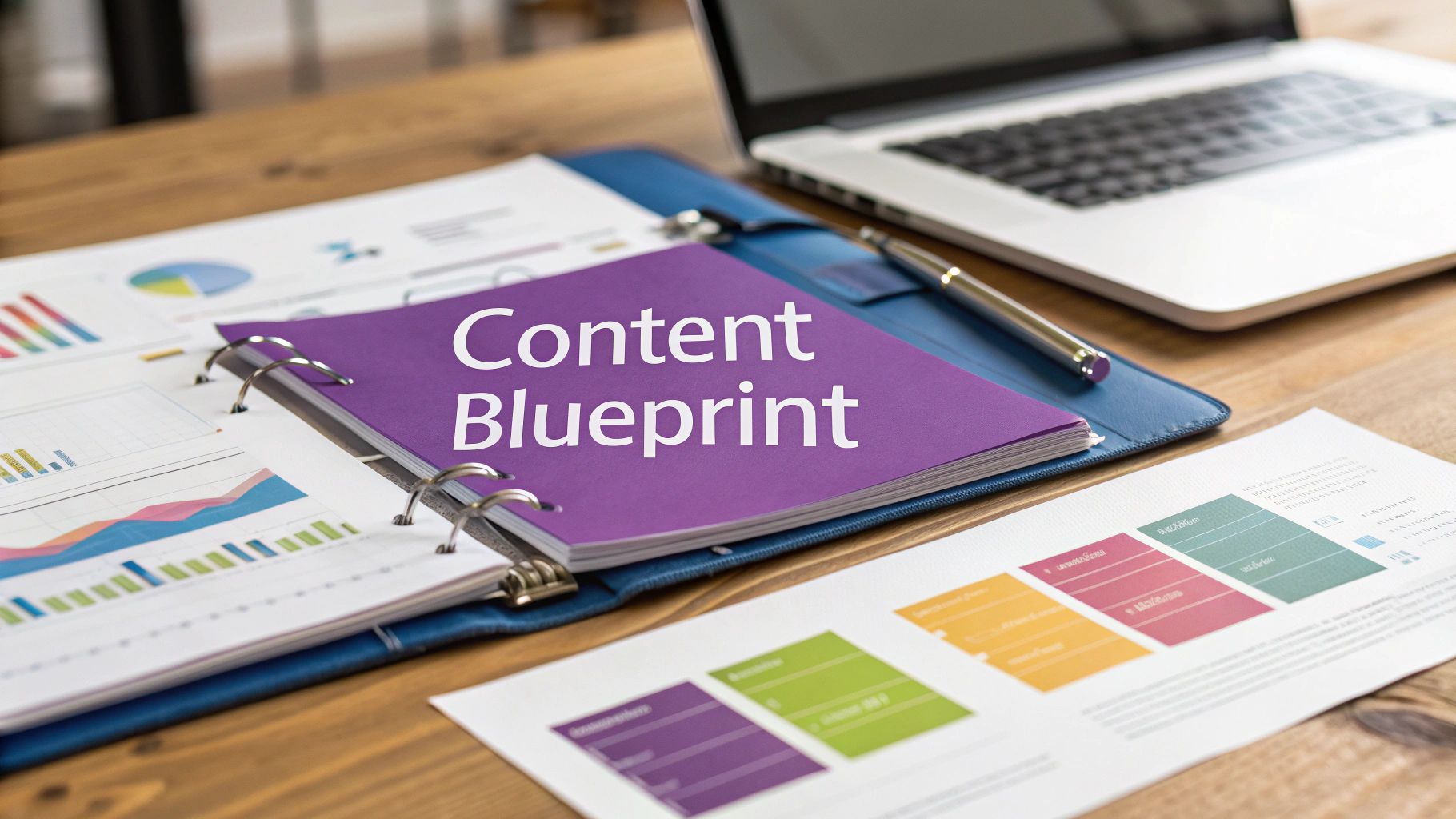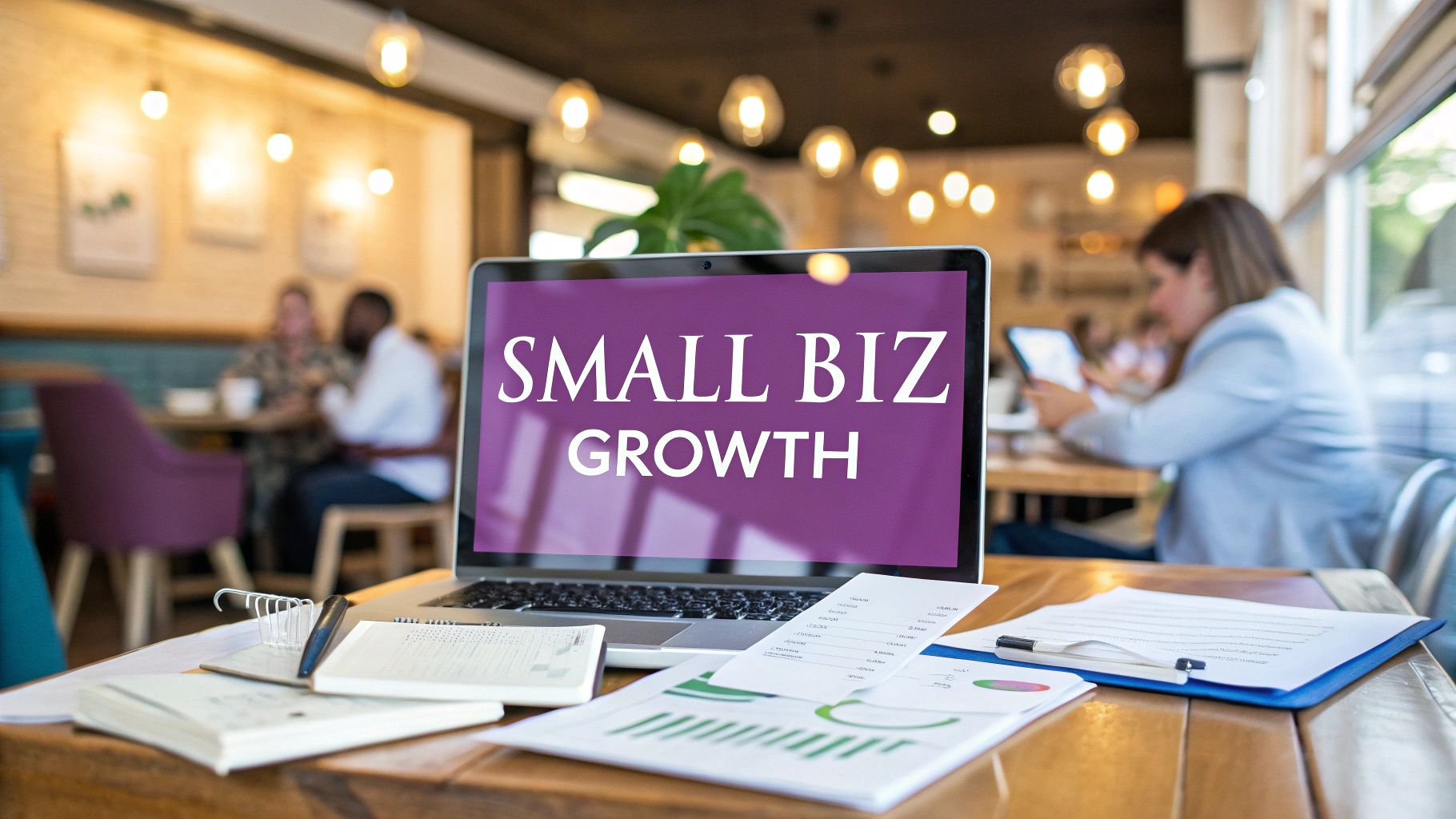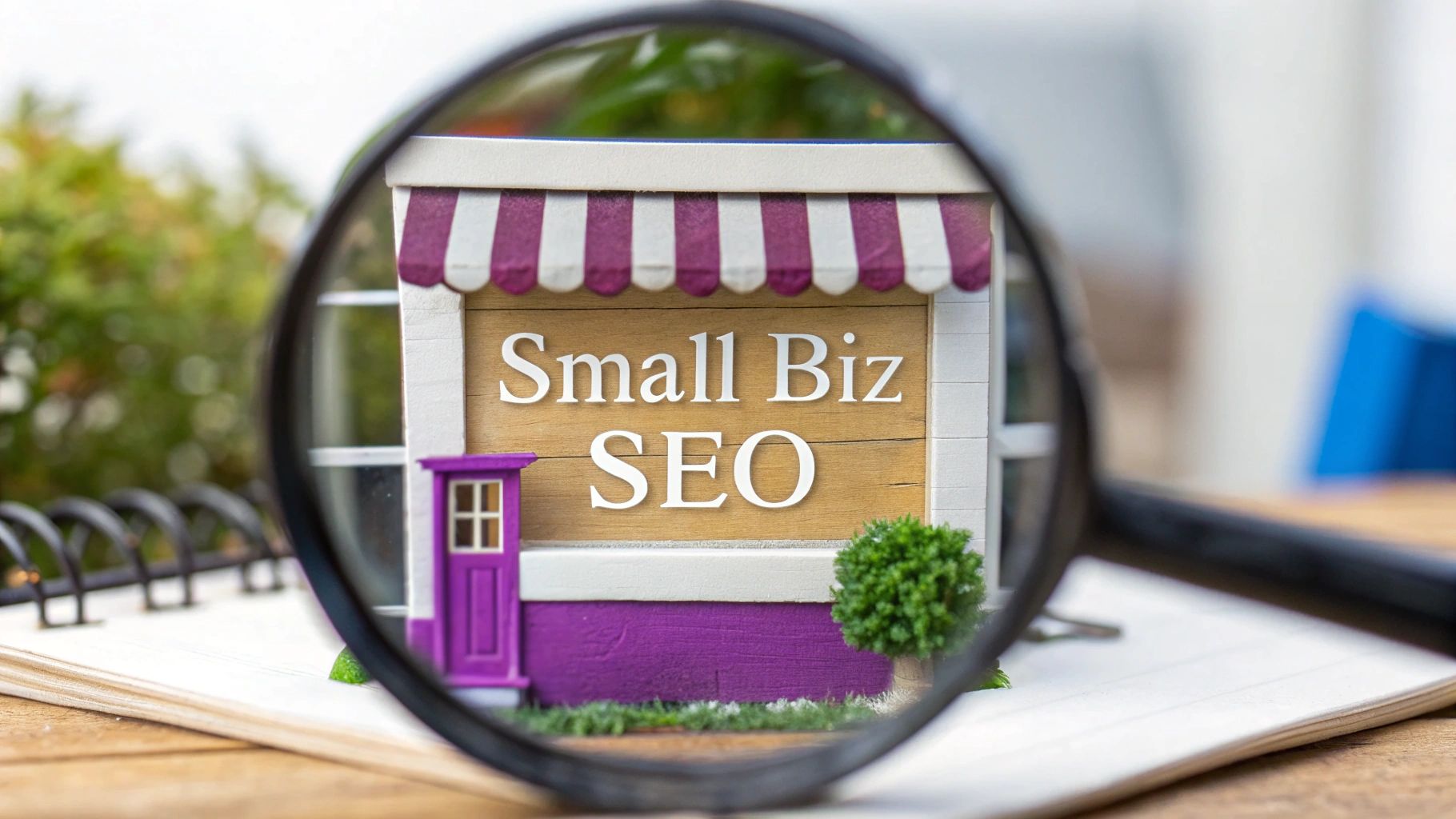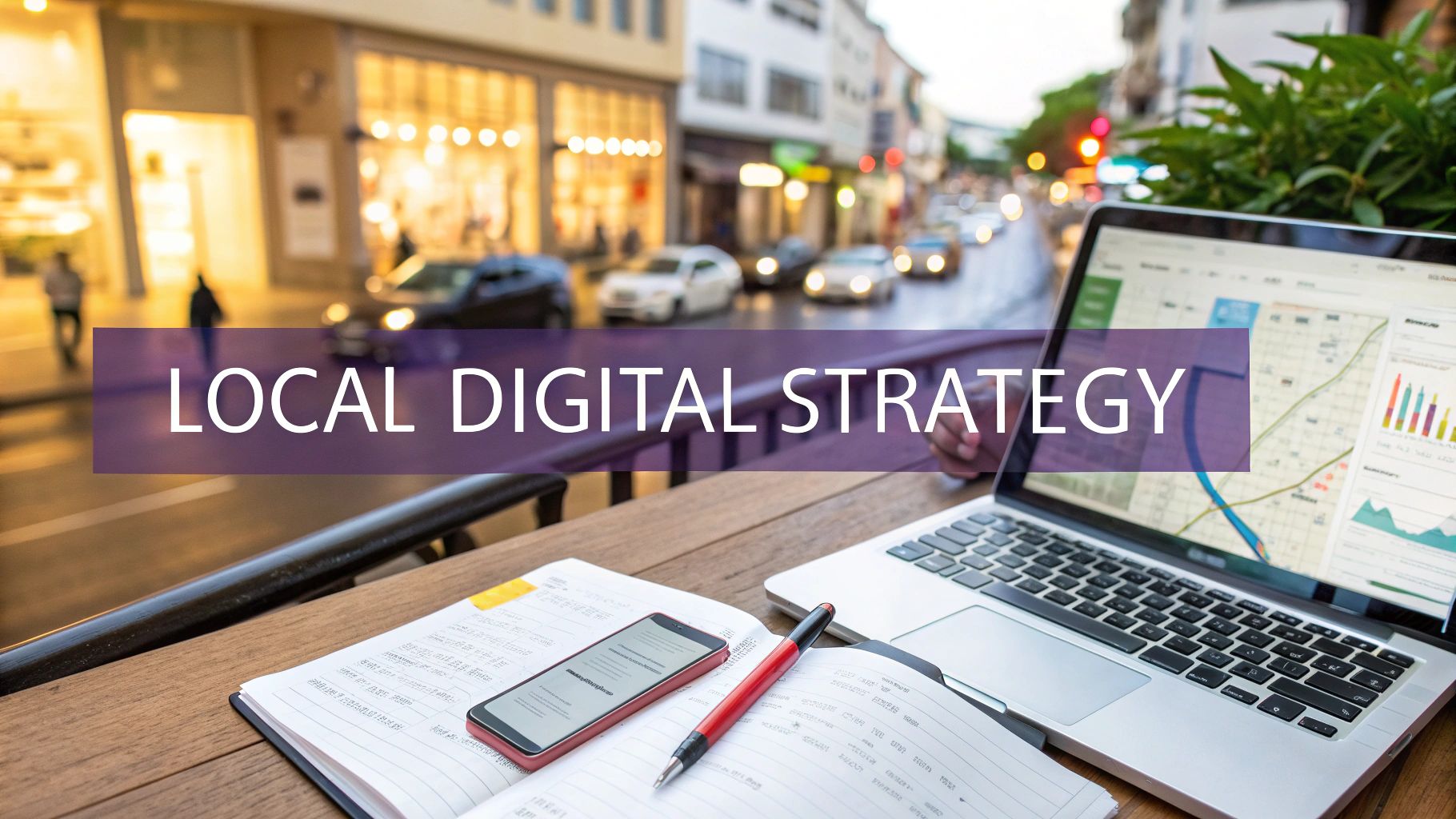Setting Goals That Connect to Your Bottom Line
A solid digital marketing plan doesn’t begin with picking channels or tactics. It starts with a crystal-clear picture of what you actually want to achieve for your business. For many Brisbane SMEs, this is the first hurdle. It’s all too easy to get distracted by chasing “more followers” or “more website traffic.” While these sound great, they are often vanity metrics—they look impressive on paper but don’t necessarily translate into revenue.
Let’s ground this with a real-world example. Imagine a local cafe in New Farm aiming for “more Instagram likes.” It’s a fuzzy goal. A much stronger objective would be to “increase weekend brunch bookings by 20% over the next three months using targeted social media campaigns.” This target is specific, measurable, and links directly to your bottom line. It changes the focus from just being popular online to being profitable.
Beyond Standard Goal-Setting Frameworks
You’ve probably come across SMART (Specific, Measurable, Achievable, Relevant, Time-bound) goals. It’s a decent framework, but it can sometimes feel a bit rigid for the dynamic nature of digital marketing. A high-impact strategy often uses a layered approach, connecting your big business ambitions to your daily marketing tasks. This means setting goals that cascade down from your ultimate business objective.
For instance, a professional services firm in Brisbane’s CBD might have a primary business goal to grow annual revenue. This can be broken down into a marketing goal, like generating 40 qualified leads per month. That, in turn, informs specific channel goals:
- SEO: Achieve a top-three ranking on Google for five of your core service-related keywords.
- PPC: Maintain a cost per acquisition (CPA) below $150 on your Google Ads campaigns.
- Content: Publish two detailed case studies each month to demonstrate expertise and build trust.
This tiered structure creates a direct line of sight from a single blog post all the way up to your financial targets. It ensures every dollar and hour you invest has a clear purpose. With Australian digital advertising spend growing by 7.3% to reach $14.5 billion in 2024, it’s clear businesses are investing heavily online and expecting a return. You can find more insights on this trend in the detailed analysis from Meltwater.
To help you decide on the right type of goals for your Brisbane SME, here’s a table comparing different goal categories and what you can expect from each.
| Goal Type | Timeline | Key Metrics | Expected ROI | Brisbane SME Suitability |
|---|---|---|---|---|
| Brand Awareness | 6-12+ months | Social Media Reach, Impressions, Website Traffic, Branded Search Volume | Long-term brand equity, not immediate sales. | High: Crucial for new businesses or those in competitive spaces like hospitality or retail. |
| Lead Generation | 3-6 months | Form Submissions, Phone Calls, Email Sign-ups, Cost Per Lead (CPL) | Mid-term, as leads need nurturing before they convert. | High: Essential for B2B firms, trades, and professional services in areas like the CBD or Fortitude Valley. |
| Direct Sales/Conversions | 1-3 months | Online Sales, E-commerce Conversion Rate, Return on Ad Spend (ROAS) | Short-term and highly measurable. | High: Perfect for e-commerce stores and businesses offering bookable services online. |
| Customer Loyalty | Ongoing | Repeat Purchase Rate, Customer Lifetime Value (CLV), Email Open/Click Rates | Long-term and cumulative, building sustainable revenue. | Medium to High: Vital for businesses with repeat customers, like local cafes, gyms, or salons. |
This table shows there isn’t a one-size-fits-all answer. A new retail shop in West End might prioritise Brand Awareness first, while an established plumbing service in Chermside will likely focus on Lead Generation. The key is to pick the goals that match your current business needs.
Visualising Your Strategic Focus
Once your goals are set, you need to put your money where your mouth is. Allocating your budget effectively is what brings your strategy to life. The chart below shows a typical budget split for a local SME aiming for balanced growth across different channels.
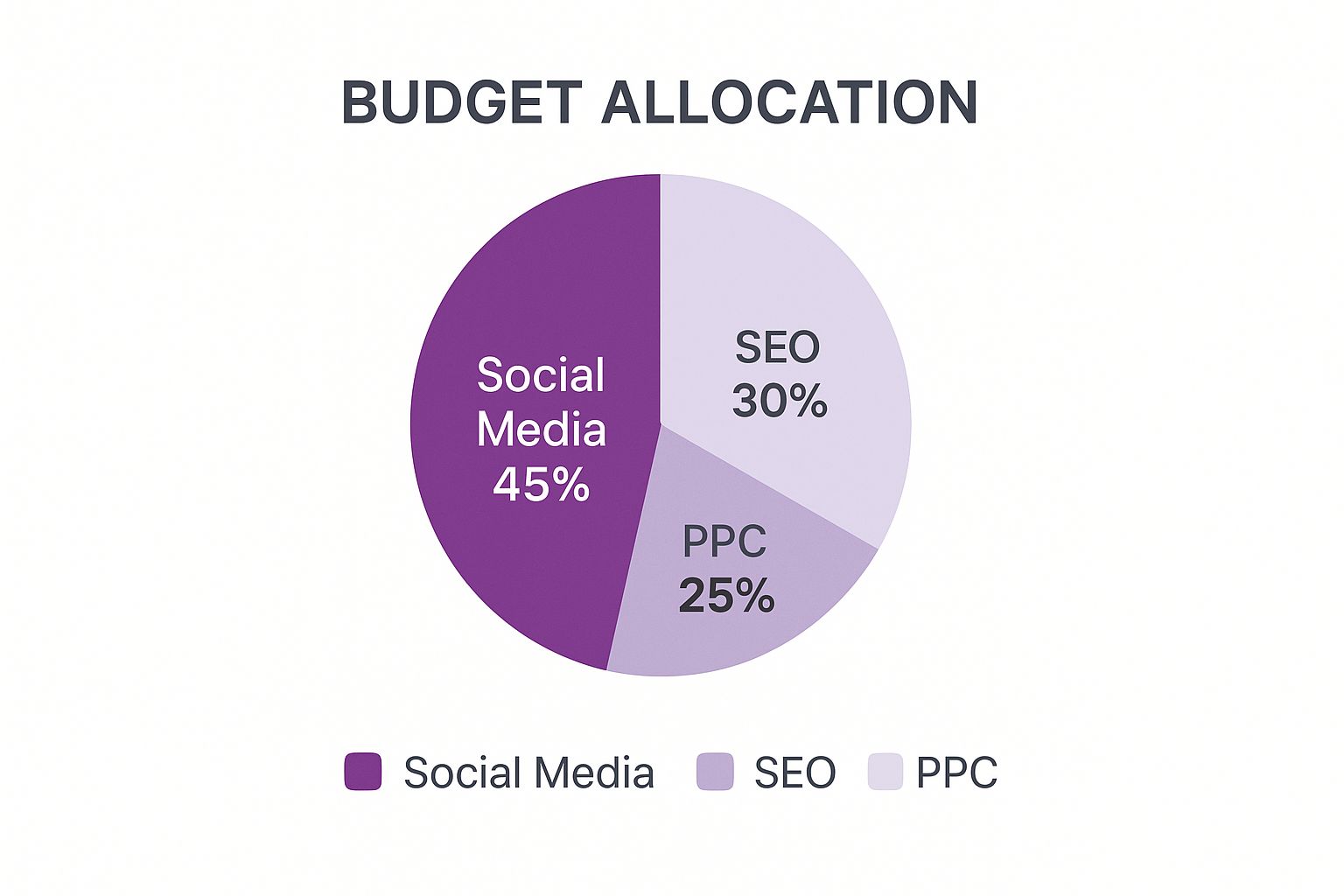
This particular allocation highlights a strong focus on social media for building an immediate community connection, backed by a solid investment in SEO for sustainable, long-term organic growth. Creating clear, revenue-focused goals and a matching budget is the foundational step in building a digital marketing strategy that delivers real, measurable success for your Brisbane business.
Getting Inside Your Brisbane Customers’ Heads
A solid digital marketing strategy doesn’t begin with your business; it starts with your customers. Too many Brisbane businesses create generic buyer personas that are more fiction than reality. A profile that simply says “Sarah, 35, lives in the suburbs, likes coffee” is practically useless. For real results, you need to get into the nitty-gritty of how your local customers actually make decisions.

True customer understanding goes beyond simple demographics to uncover what genuinely motivates them. It’s about knowing why a customer in Fortitude Valley picks one bar over another, or what specific frustrations a client of a Paddington-based consultancy faces before they even think about seeking help. This depth of insight lets you create marketing that feels personal and relevant. It’s the difference between shouting into a crowd and having a meaningful one-on-one conversation.
Uncovering What Truly Drives Decisions
To get these insights, you need to ask smarter questions and use the right tools. Your aim is to map out the customer journey, identifying the specific thoughts, feelings, and frustrations they experience at every touchpoint.
A great place to start is by talking to the people who know your customers best: your sales and customer service teams. They’re on the front lines every single day. Ask them:
- What are the top three questions prospects always ask?
- What’s the biggest “aha!” moment customers have when they finally understand your product?
- What are the most common objections or hesitations they hear before a sale?
Beyond internal conversations, you can use digital tools to listen in. Social listening tools can monitor conversations about your brand, competitors, and industry right here in Brisbane. What language are people using? What problems are they trying to solve? Tools like Google Analytics also show how users behave on your site, revealing which pages they visit and where they drop off, giving you clues about their interests. This combined approach prevents the kind of messaging mismatch that leads to ineffective campaigns and helps you avoid common email marketing mistakes that arise from not knowing what your audience truly wants.
Segmenting Your Brisbane Audience for Impact
Once you’ve gathered this rich data, you can segment your audience based on behaviour and local nuances, not just age or location. Think about the distinct lifestyle and business culture here in Brisbane. A tradie in Rocklea has completely different online habits and responds to different triggers than an office worker in the CBD.
To help you visualise this, here’s a framework for thinking about local segmentation. It moves beyond basic demographics to focus on channel behaviour and local triggers.
Brisbane Market Segmentation Framework
Detailed breakdown of Brisbane demographic segments with preferred digital channels and engagement patterns
| Market Segment | Primary Channels | Peak Activity Times | Content Preferences | Local Triggers |
|---|---|---|---|---|
| Inner-City Young Professionals | Instagram, LinkedIn, TikTok | 7–9 AM, 6–9 PM Weekdays | Short-form video, event-based content, career advice | New restaurant openings, live music events, professional networking |
| Suburban Families | Facebook, Pinterest, Local Community Groups | 8–11 PM Weeknights, Weekends | How-to guides, family activity ideas, reviews and testimonials | School holidays, local sports events, community markets |
| B2B Service Providers | LinkedIn, Google Search, Industry-specific forums | Business Hours (Mon–Fri) | Case studies, whitepapers, webinars, expert interviews | End of financial year, local business awards, new infrastructure projects |
This framework isn’t just about grouping people; it’s about understanding their context. Knowing these patterns allows you to put the right message on the right channel at the exact moment it will have the most impact. This is how you build a digital marketing strategy that connects deeply with your Brisbane audience and drives real business results.
Dominating Local Search Like Brisbane’s Top Performers
To really make your mark in Brisbane’s lively market, your digital marketing needs to be a master of local search. It’s not just about having a website; it’s about showing up as the best solution the moment a local customer starts looking. Picture this: someone in Paddington needs a plumber. They aren’t just typing “plumber” into Google; they’re searching for “plumber near me” or “best plumber Paddington.” Nailing this local intent is how you can genuinely outshine the big national players who just don’t have your neighbourhood insight.
The foundation of any solid local search plan is your Google Business Profile (GBP). So many businesses set one up and then let it gather digital dust, which is a huge mistake. Your GBP is more than a simple listing—it’s an interactive storefront. When you consistently upload high-quality photos of your work, encourage customer reviews (and reply to all of them), and use the Q&A section to answer common questions, you’re sending strong signals to Google that you’re an active, credible local business. This ongoing activity is often what separates businesses in the highly-visible Google Map Pack from those that are buried on page two.
Beyond the Basics: Advanced Local SEO Tactics
Once your GBP is up and running smoothly, it’s time to go a bit deeper. Consider how people actually search here in Brisbane. Voice searches are on the rise, with people asking their phones questions like, “Where’s a good cafe with parking in Newstead?” To show up for these queries, your website’s content needs to mirror this natural, conversational style. Try weaving local landmarks and suburb-specific terms into your blog posts and service pages. A real estate agent, for instance, could write a blog titled “The Best Suburbs for Young Families Near the M1 Corridor.” This kind of specific detail is invaluable.
Building local authority also means getting digital “shout-outs” from other respected Brisbane businesses and organisations. This could look like:
- Sponsoring a local junior sports team and getting a link from their website.
- Teaming up with a complementary, non-competing business in your suburb for a joint promotion.
- Getting a feature in a local Brisbane blog or news site for an event you’re hosting.
These local backlinks show search engines that you’re a trusted and important part of the Brisbane community, boosting your credibility much more effectively than a random link from a generic directory.
Capitalising on Search Behaviour
Understanding how Australians find new brands is fundamental. The data is clear: search engines are the number one tool for brand research, with 62.5% of Australian internet users turning to search when investigating a business. This figure easily beats other channels like brand websites (36.8%) or social media (33.6%), highlighting that search is the main arena where you need to be visible. This insight shows why a thought-out local SEO and search ads plan isn’t just a “nice-to-have” but a core part of your growth. You can dive into more of these Australian consumer habits in this detailed report.
By getting these elements right—from a perfectly tuned GBP to a content strategy that speaks the local language—you can completely change your search presence. It’s all about being seen precisely when and where your Brisbane customers are searching. For anyone wanting to take a closer look at securing those top map results, you might find value in our definitive guide to ranking in the Google Map Pack.
Social Media That Builds Real Business Relationships
It’s easy to get caught up in a numbers game with social media, chasing likes and follower counts. But for Brisbane businesses, the real value isn’t in those vanity metrics. It’s in building genuine relationships that actually lead to sales. Success comes from understanding both the platform algorithms and the unique vibe of our local communities, from the CBD laneways to the bustling suburban hubs.
This means shifting away from generic posts and creating content that feels like a real conversation. Think about a cool cafe in West End. Instead of just posting a photo of a coffee, they could share a video of their barista perfecting a new latte art design and tag the local artist whose work hangs on their walls. This approach does more than just showcase a product; it builds community and tells a story that Brisbane locals connect with, making them feel like part of something special.
Choosing Platforms That Align With Your Business
Not every social media platform will be a good fit for your Brisbane SME. The trick is to be strategic and focus your energy where your ideal customers are actually spending their time. A B2B consultancy aiming to connect with professional services firms would be smart to create authoritative content for LinkedIn. On the other hand, a boutique clothing store in Paddington would likely find its audience on visual platforms like Instagram and Pinterest.
To help you decide, here are a few platform-specific ideas:
- Facebook: Still a powerhouse for community building, especially for businesses with a broad local audience. It’s perfect for promoting events, sharing customer success stories, and engaging with local community groups.
- Instagram & TikTok: These are your go-to platforms if your business is highly visual, like hospitality, retail, or tourism. Success here is all about capturing Brisbane’s vibrant lifestyle through high-quality Reels, Stories, and authentic, unpolished video clips.
- LinkedIn: The essential platform for any B2B company. It’s not just a digital resume; it’s a space to establish your expertise through well-written articles, share company news, and network with other local business leaders. If you’re in professional services, it’s worth reviewing your current strategy to ensure you’re using LinkedIn marketing effectively.
Turning Engagement Into Revenue
Authentic engagement is what turns a social media follower into a paying customer. This requires creating content that encourages interaction, not just a quick glance. Ask your audience questions, run polls about potential new products, and make sure you respond thoughtfully to every single comment. Your goal is to make your social channels a hub for real connection.
This strategy is backed by serious investment from businesses across the country. In fact, social media ad spending in Australia is forecast to reach AU$7.5 billion in 2025 and is projected to grow by 7.74% annually until 2030. This shows just how crucial social media has become for connecting with consumers. You can dive deeper into these figures and find other useful Australian marketing statistics from Eloquent.
By combining genuine, organic content with carefully targeted paid ads, you can make sure your message reaches the right Brisbane audience, effectively turning online chats into real-world business.
Paid Advertising That Maximises Every Dollar
While organic channels like SEO and social media are fantastic for building long-term trust, paid advertising gives you that immediate, targeted traffic right when you need it. For a Brisbane SME, winning on platforms like Google Ads or Facebook isn’t about having the deepest pockets; it’s about being smarter and more strategic than the national players. A well-planned paid ad campaign is a serious asset in your digital marketing strategy, capable of bringing in leads and sales from the get-go.
First things first, you need to think like a local. How does someone in Brisbane actually search for things? A homeowner in The Gap probably isn’t just typing “landscapers.” They’re more likely searching for “The Gap garden maintenance” or “best landscapers Brisbane northside.” Your first big advantage is identifying these high-intent keywords that mention specific suburbs or familiar landmarks. This local focus means you’re not fighting with everyone, and the people clicking your ads are far more likely to be genuine, ready-to-buy customers.
Crafting Campaigns for Local Impact
Once you’ve got your keywords sorted, your ad copy needs to sound like it was written by a local, for a local. Drop the generic corporate speak and add some Brisbane flavour. For instance, a roofing company could run an ad that says, “Brisbane Storm Season Is Coming. Is Your Roof Ready? Get a Free Inspection in Aspley.” This message is timely, highly relevant, and builds an instant connection.
How you structure your campaigns on a platform like Google Ads is also key to making every dollar count. Instead of throwing all your services and suburbs into one big, messy campaign, create separate ad groups for each. One for “emergency plumbing in Chermside,” another for “hot water system installation in Nundah.” This allows you to:
- Write super-specific ad copy for every service.
- Send people to the exact right page on your website.
- Allocate your budget based on which services are most profitable.
This detailed approach gives you much more control and a better Return on Ad Spend (ROAS) because you stop wasting money showing people ads they don’t care about.
Advanced Targeting and Retargeting
Modern ad platforms have some amazing targeting tools. On Facebook, you can show your ads to people within a few kilometres of your shop or to those who’ve shown interest in local events like the Ekka. This is perfect for a cafe in South Bank wanting to promote a weekend special or a boutique in Fortitude Valley launching a new clothing line.
And whatever you do, don’t overlook the power of retargeting. This is your chance to show ads to people who have already visited your website but left without making a purchase or enquiry. For a Brisbane business, this is incredibly powerful. Think about it: a potential customer might browse your site during their lunch break in the CBD but get pulled into a meeting. A friendly reminder ad that pops up on their feed later that evening can be the perfect nudge they need to finish what they started.
By combining these precise paid tactics with your organic marketing, you create a robust, multi-channel strategy that connects with customers at every point of their journey, ensuring every dollar you spend is working as hard as you do.
Content That Establishes You as the Local Authority
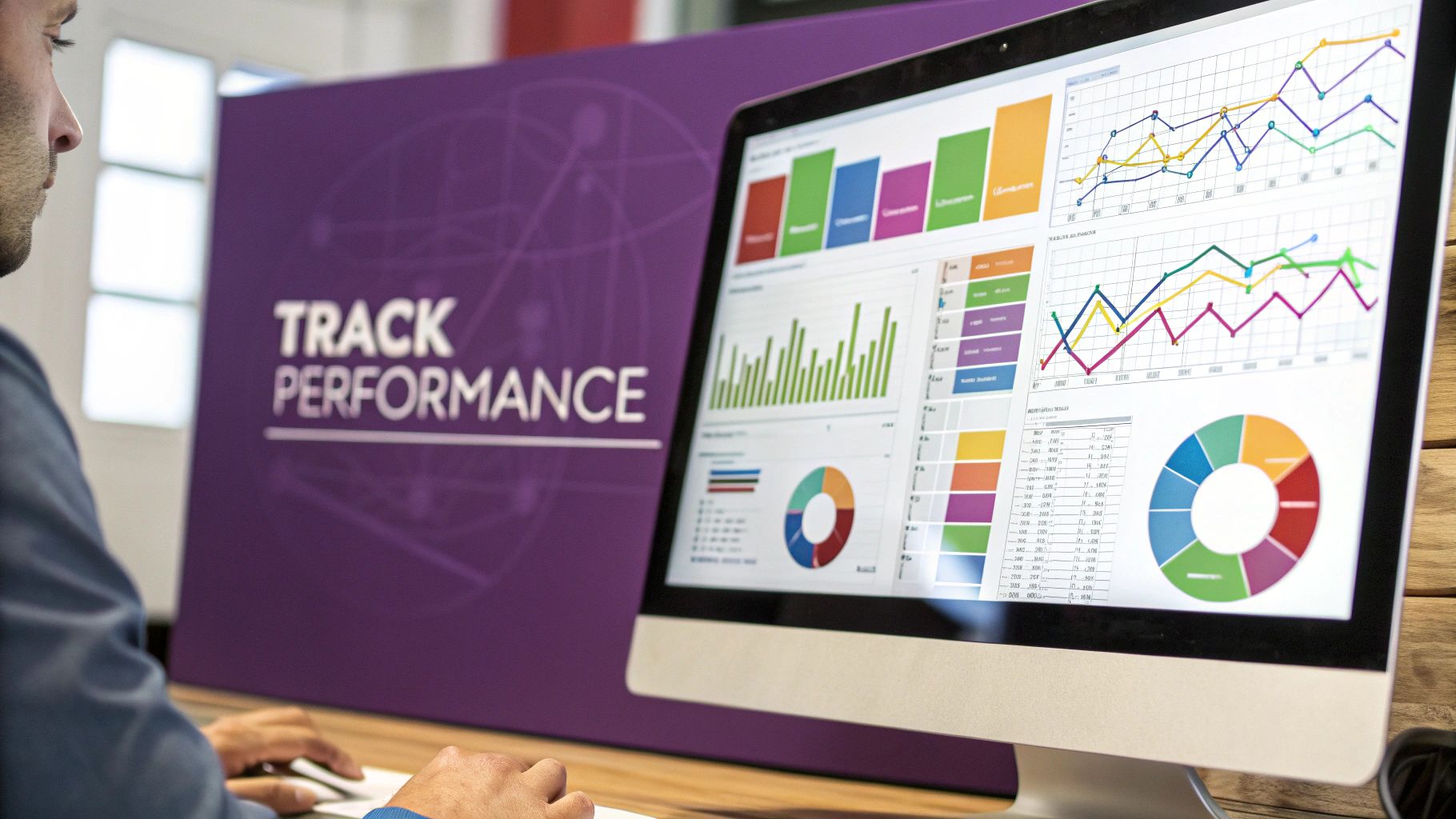
A solid content marketing plan within your digital marketing strategy is about becoming the first name people think of in the Brisbane market. It’s not about pumping out generic articles; it’s about creating real value that builds trust and cements your SME as the local expert. This means you need to shift from just selling to actually educating, informing, and solving problems that are specific to your Brisbane customers.
Here’s a practical example: instead of a bland “5 Tips for Home Renovation” post, a Brisbane builder could publish a guide on “Navigating Brisbane City Council Approvals for Your Deck Extension.” This hyper-local title immediately screams relevance and expertise. It grabs organic traffic from people who are past the dreaming stage and are actively planning a project. When you weave in local stories, suburb-specific advice, and real case studies from projects in areas like Paddington or Bulimba, you create something that big national chains simply can’t copy.
Content Formats That Resonate with a Brisbane Audience
A good content plan uses a mix of formats to keep things interesting and cater to how different people like to consume information. Detailed blog posts are fantastic for SEO and showing your expertise, but other formats can grab attention in different ways.
- Video Walkthroughs: A real estate agent could film tours of entire neighbourhoods, not just houses. Imagine showing off the best local cafes, parks, and schools in a suburb—that’s pure gold for potential buyers.
- Customer Success Stories: Feature a local Brisbane business you’ve helped. Tell the story of their problem and how your solution made a difference. This is incredibly powerful social proof.
- Hyper-Local ‘How-To’ Guides: A mechanic in Chermside could create a checklist for getting your car ready for a weekend trip up to the Sunshine Coast. It’s practical, useful, and location-specific.
- Infographics with Local Data: Create visuals with data that matters to Brisbane locals, like “Peak Commute Times from North Lakes to the CBD” or “The Most Dog-Friendly Parks in Brisbane’s Inner-Suburbs.”
The goal is always to answer the questions your specific Brisbane customers are already asking online. This makes you an essential resource, building a relationship long before they even think about making a purchase.
Amplifying Your Content’s Reach
Creating brilliant content is only half the job; you also need a smart plan to make sure people see it. This involves sharing your content on the channels where your audience actually spends their time. A detailed article on B2B financial services, for instance, is perfect for sharing on LinkedIn, while a visual story about a local event will likely do much better on Instagram or Facebook.
Understanding who uses which platform is also helpful. For instance, as of early 2025, X (formerly Twitter) had 5.25 million users in Australia. While that’s a smaller slice of the population (19.6%), it can be a very active audience for certain sectors like tech, news, and professional services. You can dig deeper into platform-specific data in the full Digital 2025 report for Australia. When you link your content creation with your SEO and social media activity, you build a system where everything works together, driving more and more growth over time.
Tracking What Matters and Improving What Works
The real difference between a profitable digital marketing strategy and an expensive hobby lies in the data. You can have brilliant goals and wildly creative campaigns, but if you’re not tracking performance, you’re flying blind. For Brisbane SMEs, measuring what truly matters is how you stop wasting money and start making decisions that build on each other, compounding your results over time.
This isn’t about getting lost in a sea of confusing charts. It’s about zeroing in on the specific numbers that show if your strategy is actually growing your business. Instead of obsessing over vanity metrics like social media likes, you need to look at the data that connects directly to your bottom line.
Identifying Your Key Performance Indicators
First things first, you need to define your Key Performance Indicators (KPIs) for each channel. These are the core metrics that tell you if you’re on track to hit your business goals. What you measure for an SEO campaign will be completely different from what you track for a paid social media ad. A clear framework is essential to keep everything organised and focused.
To give you a practical idea, here’s a table showing how you can structure this for your Brisbane business. It helps you hold your marketing accountable and turns vague activities into a structured process focused on constant improvement.
Essential KPIs by Marketing Channel
Comprehensive metrics tracking framework showing primary and secondary KPIs for each digital marketing channel
| Marketing Channel | Primary KPIs | Secondary Metrics | Reporting Frequency | Optimisation Actions |
|---|---|---|---|---|
| Local SEO | Organic Traffic, Google Map Pack Rankings, Phone Calls from GBP | Branded Search Volume, Backlink Growth, Keyword Ranking Changes | Monthly | Adjust on-page content based on keyword performance, update Google Business Profile with new posts and photos. |
| Google Ads | Return on Ad Spend (ROAS), Cost Per Acquisition (CPA), Conversion Rate | Click-Through Rate (CTR), Quality Score, Impression Share | Weekly | Pause underperforming keywords, adjust ad copy based on CTR, reallocate budget to high-converting campaigns. |
| Social Media | Engagement Rate, Website Clicks, Leads from Social | Follower Growth, Reach, Post Shares | Fortnightly | Double down on content formats that drive the most engagement, refine audience targeting for paid posts. |
| Content Marketing | Leads Generated, Time on Page, New Users from Organic Search | Social Shares, Email Subscribers from Blog, Scroll Depth | Monthly | Identify topics for new content based on high-performing posts, add stronger calls-to-action on popular pages. |
Having a clear dashboard like this ensures you’re not just doing marketing, but you’re doing marketing that works.
From Data to Actionable Insights
Having the data is one thing; knowing what to do with it is the real skill. Tools like Google Analytics are fantastic for understanding how people behave on your website.
For example, take a look at this Google Analytics snapshot showing where website traffic comes from.
From this, we can quickly see that Organic Search is the biggest traffic driver—a great sign for our SEO efforts. But look closer. The bounce rate from social media is quite high. This suggests visitors arriving from those platforms might not be finding what they expected.
This single insight gives us a clear action: review the social media posts and the landing pages they link to. We need to make sure the messaging is aligned to improve the user experience and, ultimately, drive more conversions. This is the heart of an effective marketing strategy: turning observation into optimisation.
This cycle of measuring, analysing, and refining ensures your strategy doesn’t become static. It grows with your business and the market, making your marketing more effective and profitable over time.
At CAYD Marketing, we specialise in turning data into real results. We build and manage integrated campaigns for Brisbane businesses, ensuring every part of your strategy is measured, optimised, and aligned with your growth goals. Ready to build a marketing plan that delivers a genuine ROI? Get in touch with CAYD Marketing today and let’s create a strategy that works for you.
